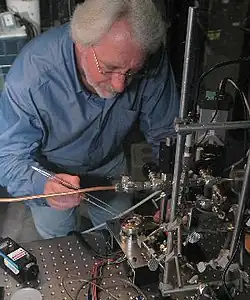Michael McKubre
Michael Charles Harold McKubre is an electrochemist involved with cold fusion energy research.[1][2] McKubre was the director of the Energy Research Center at SRI International in 1998.[3] He is a native of New Zealand.[2]
Michael McKubre | |
|---|---|
 Michael McKubre working on deuterium gas-based cold fusion cell used by SRI International. | |
| Born | |
| Alma mater | Victoria University of Wellington |
| Scientific career | |
| Fields | cold fusion |
| Institutions | SRI International |
| Thesis | An Impedance Study of the Membrane Polarisation Effect in Simulated Rock Systems (1976) |
| Doctoral advisor | John Tomlinson |
Education
McKubre completed two degrees at Victoria University of Wellington, a Master's degree in 1972, titled A Study of the Frequency Domain Induced Polarisation Effects Displayed by Clay and by Cation Exchange Resin, Model Soil Systems,[4] followed by a PhD in 1976 on membrane polarisation effects in simulated rock systems.[5]
Career
From 1989 to 2002, he researched cold fusion at SRI International.[6] Unlike other researchers in the same field, he obtained mainstream funding during all his research: first from the Electric Power Research Institute, then from the Japanese government, and in 2002 he had funding from the U.S. government.[6]
In January 1992 a cold fusion cell exploded in an SRI lab. One of McKubre's collaborators was killed and three people including McKubre were wounded.[3][7] McKubre still has pieces of glass embedded in his side. Subsequent experiments were done behind bulletproof glass.[2]
In 2004 he and other cold fusion researchers asked the United States Department of Energy (DOE) to give a new review to the field of cold fusion, and he co-authored a report with all the available experimental and theoretical evidence since the 1989 review. The 2004 review concluded that "while significant progress has been made in the sophistication of calorimeters since the review of this subject in 1989, the conclusions reached by the reviewers today are similar to those found in the 1989 review."[8]
As of 2010, he was still making experiments with palladium cells at SRI International,[9] and collaborates with the ENEA laboratory, where the most reliable palladium is being produced.[1] McKubre more recently took part as one of the 22 physicists of the Steorn "jury".
Selected publications
- Hagelstein, Peter; Michael, McKubre; Nagel, David; Chubb, Talbot; Hekman, Randall (2004). New Physical Effects in Metal Deuterides (PDF). Washington: US Department of Energy. Archived from the original on 2007-01-06.
{{cite book}}: CS1 maint: bot: original URL status unknown (link) (manuscript) Paper listing the available experimental evidence of cold fusion.
References
- "Cold Fusion Is Hot Again". 60 Minutes. CBS. 2004-04-29. Retrieved 2012-02-10.
- Weinberger, Sharon (2004-11-21). "Warming Up to Cold Fusion". Washington Post. p. W22.
For years the experiments took place behind bulletproof glass, the result of a 1992 accident that killed one of his colleagues. McKubre still has bits of glass embedded in his side from the cold fusion experiment that exploded that day in his lab (the blast had nothing to do with fusion; hydrogen mixed with oxygen, creating the equivalent of rocket fuel).
- Wieners, Michael; Storms, Edmund (November 1998). "Michael McKubre & Edmund Storms Give Birth To The Cool". Wired. Vol. 6, no. 11.
- McKubre, Michael (1972). A Study of the Frequency Domain Induced Polarisation Effects Displayed by Clay and by Cation Exchange Resin, Model Soil Systems (Masters thesis). Open Access Repository Victoria University of Wellington, Victoria University of Wellington. doi:10.26686/wgtn.16999291.
- McKubre, Michael (1976). An Impedance Study of the Membrane Polarisation Effect in Simulated Rock Systems (Doctoral thesis). Open Access Repository Victoria University of Wellington, Victoria University of Wellington. doi:10.26686/wgtn.16999279.
- Interview of McKubre and Beaudette, by KUER-FM from University of Utah, audio file Archived 2005-03-24 at the Wayback Machine, 2002-11-27
- Sheldon, E. (September–October 2008). "An overview of almost 20 years' research on cold fusion". Contemporary Physics. 49 (5): 375–378. Bibcode:2008ConPh..49..375S. doi:10.1080/00107510802465229. S2CID 119406105.
an explosion in January 1992 caused a cold fusion cell at SRI International in Menlo Park to blow up violently while Andrew Riley was bending over it, killing him instantly and wounding three other researchers, including Michael McKubre, who headed SRI's research team (the incident is described in New Scientist, 11 January 1992, 1803, p. 12ff).
- U.S. Department of Energy (2004). Report of the Review of Low Energy Nuclear Reactions (PDF). Washington, DC: U.S. Department of Energy. Archived from the original on 2008-02-26. Retrieved 2008-07-19.
{{cite book}}: CS1 maint: bot: original URL status unknown (link) - "Chemistry Roundup". Science Friday. 2010-03-26. Archived from the original on 2012-03-04. Retrieved 2012-02-10.
External links
 Media related to Michael McKubre at Wikimedia Commons
Media related to Michael McKubre at Wikimedia Commons